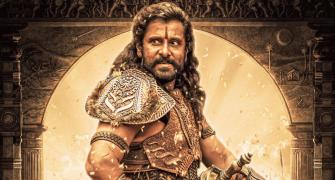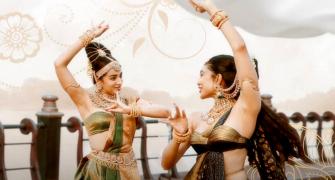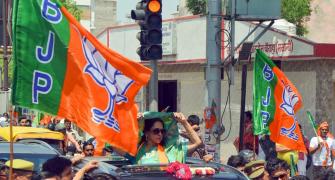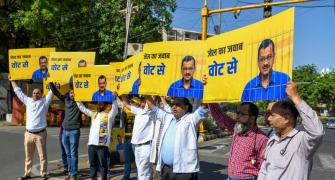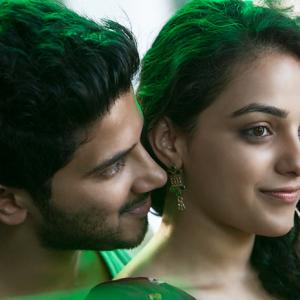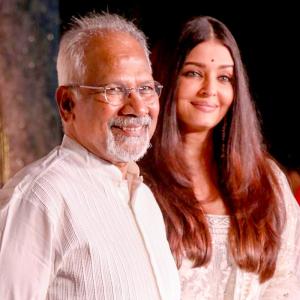Does the 'story' of a Mani Ratnam film come first or does its 'spirit', asks Sreehari Nair.
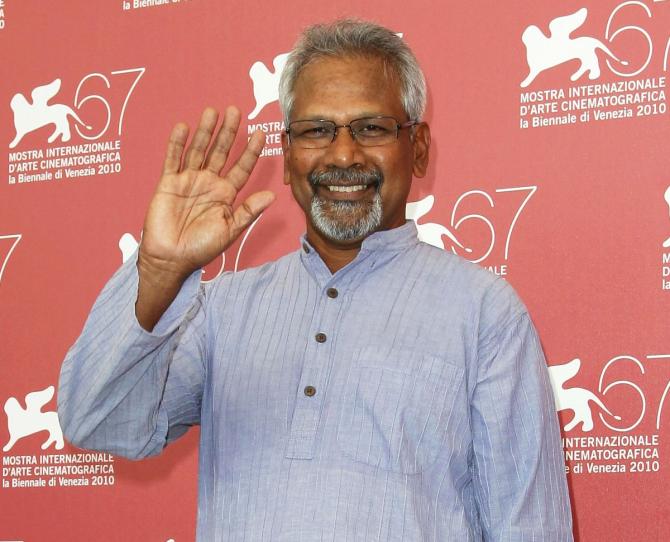
1. Does the 'story' of a Mani Ratnam film come first or does its 'spirit'?
In the case of Mani, the two aspects are so closely interlinked that I can envision situations where he must have gone frantically searching for a story that can contain the impulses prodding at his mind's eye.
The spirit of Kannathil Muthamittal is somehow linked to water -- water that alternately hugs its characters and bounds away from them.
Elsewhere, in other films, elements as diverse as rickety pagdi buildings separated by narrow turbid streets, the lurid heat of metropolitan nights, Persian poetry bubbling through the ruins of a Civil War, and morning smoke that curls out of eager mouths have provided Mani with persuasive jumping-off points.
Story and Spirit are so entwined in his films that one cannot help but wonder: Did that now-famous newspaper report of kidnapping inspire Roja, or did the all-consuming snow, the nervously fitting sweaters, the lightly stoked fires and those delicately perched creaking timber houses come first?

2. If for a particular role, it came to a tossup between a good-enough actor Mani is comfortable working with and an actor who is merely better suited to the role you can trust him to opt for the former.
As a rule, he prefers actors he can mould and shape.
His diktat for casting seems to be, 'If an actor fits well in the palm of my hand, the rest is gravy.' And yet, he continues to be a rather mild-mannered, soft-spoken man who doesn't present any signs of taking himself too seriously.

3. The twinkle in Amar's eyes when he looks at Meghna is different from the shimmer that springs from Shekhar's eyes every time he gets a glimpse of Shaila Banu.
The shine that appears in young Vijay's eyes when Anu's around is different from the flash you can trace in Lallan's eyes when he takes hold of Shashi.
Since each of the aforementioned trysts has a distinct fate, the ocular emanations either represent varying degrees of bliss or varying visions of oncoming doom.
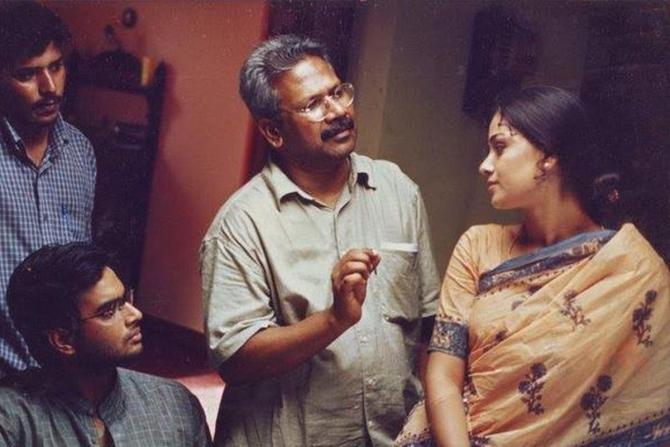
4. Mani Ratnam's kids have noses that twitch, faces that twist freely, eyes that bulge as if without instruction, smiles not easily totted out.
Mani's kids seem to move inside his frames without any restraint, and sometimes as if they are utterly bored.
The boredom I take to be indication of how unfettered the kids are.
Also, they never ever over-speak -- and this is probably why they comes across as very, very different from the precocious little ones who stick out as odious oddities in other films by other directors.

5. His feelings cluster around visual cadences.
Not all of these cadences will be celebrated in a less showy age of cinephilia, however.
Box-office emperors silhouetted against the sun, grating damsels shouting over the sound of waterfalls, lovers with frostbitten lips stretched out against expansive horizons -- these may or may not survive beyond the annals of sub-textual film criticism.
But how about that scene in Iruvar where Anandhan irritably asks his party supporters to get off his car? There, you see a giant of a man, decked up for coronation, now reeling from the hurt inflicted by his closest comrade, and as a contrast to the red inside him, the sky behind is a melancholic shade of cool gray. Oh, Shakespeare!
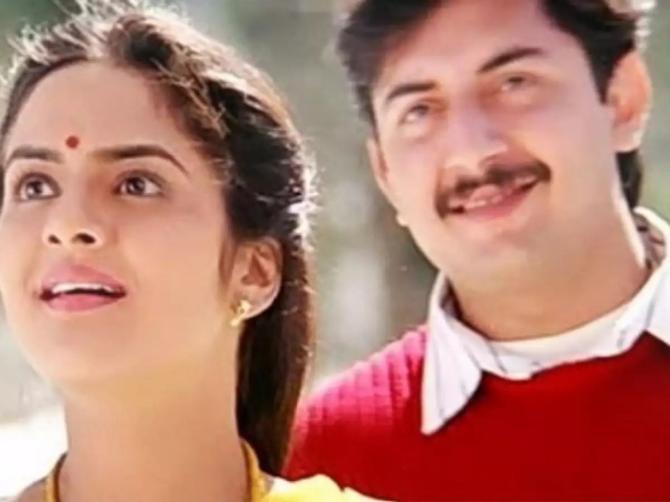
6. He borrowed from Raghu Rai the aesthetic of raising regular Indian faces and regular Indian milieus to the level of timeless snapshots, and he set these snapshots a-moving on the big screen.
I would argue that without Mani, the big revolution that happened in Indian television advertising in the 1990s would never have taken place.
He was the one who proved to us that a Rajasthani woman clad in a ghagra choli, a modest potter, a dancing grandmother and a Tibetan monk could all have their own snap and crackle.
He showed Indian ad film-makers how to use colours and weather to heighten emotions; and showed them how to animate a desert, a meadow, a church, a cow, a solitary boat journeying through a billowing river, and a simple courtyard crossed and re-crossed by a bunch of tittering bare feet.
Not just his trains, but his buses, his rickshaws, his cabs, and his way of capturing everything from an Indian monument to an Indian billboard attest to the fact that Mani Ratnam is one of the chief anatomisers of post-liberalisation India.
The first artist to achieve the pop ideal of the Indian Sublime? Quite possibly.
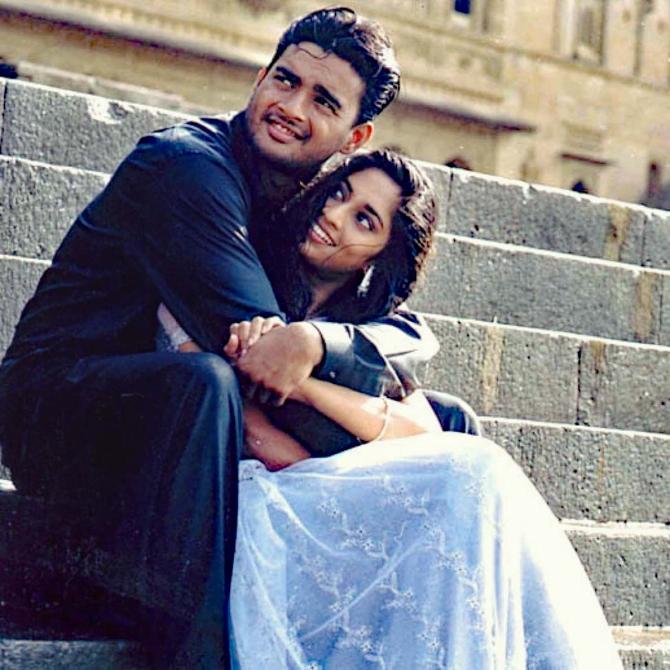
7. 2001. People travelling in a video coach bus from Bangalore to Kannur are watching Alai Payuthey.
They all laugh at the same places, cry at the same places, and every now and then someone or other stops to make an entry in his or her personal diary.
There are thirty-three passengers on the bus and thirty-two of them are watching diligently.
The one passenger who is not watching has dozed off; but in his sleep he is dreaming a dream directed by Mani Ratnam.
8. Though there are numerous scenes in his films where sex is at least hinted at, I find those scenes too aestheticised to take the sex in them seriously.
Those scenes lack everyday coarseness, which is a big part of sex.
You don't sense the rush of blood ('Sex is a blood-sport!'); you don't hear the bed sheets scratch.
The sex scenes in Mani Ratnam's films are functional: They move plots, but the lovers are hardly affected by the experience.
Sex when it comes through, comes through in campy asides: Such as the jackbooted eroticism at the start of Ninnukori Varanam, where Amala's shadow looks like a policewoman/drum majorette; or the open-chested, bare-backed dance in Thiruda Thiruda.
I daresay there's more honest exploration of sexual feelings and sexuality in Adoor Gopalakrishnan's films than there is in Mani's.

9. During moments of conflict or dramatic tension, his actors trade haikuS instead of long monologues -- Kareena and Vivek Oberoi over a bridge; Abhishek Bachchan and Arya Babbar while waiting for that deal-breaking tram; Arvind Swamy and Manisha Koirala from either side of a clothesline.
Watching such moments is like watching two people pass a ball back and forth while performing a series of seemingly sweatless but increasingly complex dance moves.
Eventually, one of the actors drops the ball, and we reach the necessary dramatic resolution.
It is satisfying, but we also feel oddly cheated. We want to know what would have happened if the ball hadn't been dropped.
10. A sample of Mani's notes to A R Rahman: 'I see browns followed by perspiration, rain, and unexpected tears. I hear a combination of Hindustani, Indian folk, marching music, and the last gasp of a Moroccan ditty. I see a woman muttering to herself as she puts papads or cow dung cakes or mangoes out to dry -- she is squatting majestically. I hear the theme music of 'a good market day.'
'Try to imagine the sound of iron screeching against iron looping into a protest rap. Think of a love song that has the same texture as a somber Navarati night. I see a self-made, self-styled God rising to a roar of applause. I see his fall and his final resurrection.'

11. Mediocre, calculating artists use cruelty and violence as a turn-on. Great artists are wise to cruelty -- they understand it, they know its special intonations.
Mani, on the other hand, is a classical humanist who is uncomfortable with violence.
He'd rather look away from acts of cruelty than tackle them head-on.
The police station torture scene in Nayakan is basic and sadistic in the vein of Kamal Hassan (for all you know, it could have been Kamal's idea).
If Mani hadn't been tied down by the demands of the plot, he would have preferred the baton-wielding policeman to be a victim of circumstances.
In Mouna Ragam, one of the characters is killed when a cop's revolver accidentally goes off following a minor road mishap.
'Mani Saar, your film was chilling and unsparing,' is not a comment that would help him sleep better.
That pristine Kashmiri girl in Roja who pinches her mouth every time cryptologist Rishi Kumar is muscled and pestered by the terrorists was probably modelled after him.
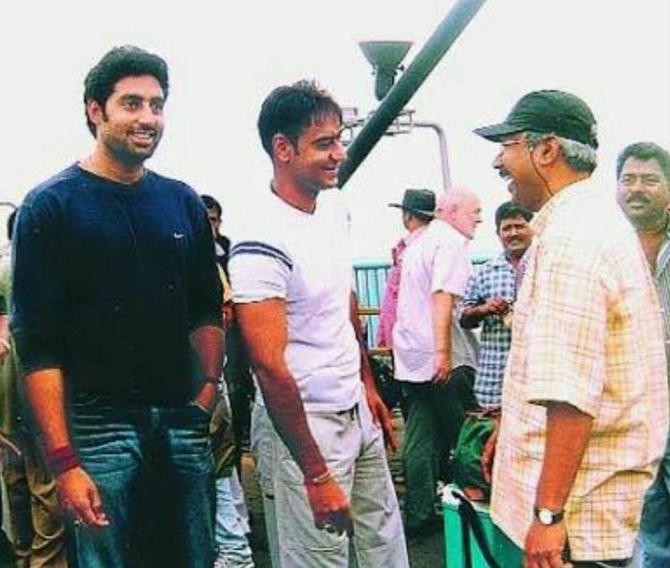
12. Titles decided by their subject matter: Gitanjali, Anjali, Roja, Bombay, Iruvar, Ponniyin Selvan.
Titles with something bodily about them: Idaya Kovil, Mouna Ragam, Dil Se..., Kannathil Muthamittal
Titles that jingle: Pallavi Anu Pallavi, Thiruda Thiruda, OK Kanmani.
Titles that tell you to wake up and do something: Unaroo, Aayutha Ezhuthu.
Nature-themed titles: Pagal Nilavu, Agni Natchathiram, Alai Payuthey, Kadal, Kaatru Veliyidai, Chekka Chivantha Vaanam.
Titles that suggest megalomania in one form or another: Nayakan, Thalapathi, Guru, Raavanan.
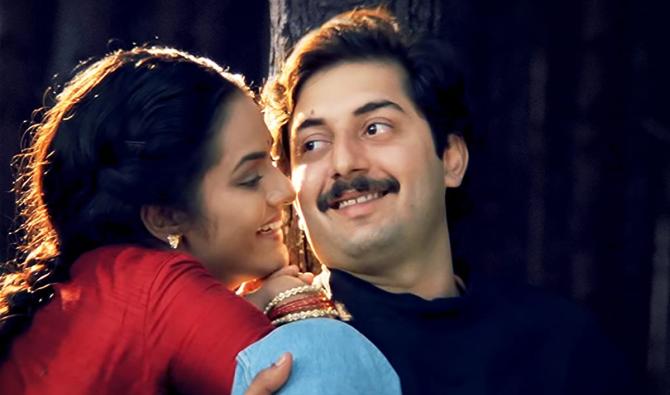
13. It's the summer of 1995. I fire an underarm off-break at Pintu who taps it to the leg side and informs me that tickets for Bombay are going for fifty rupees.
"Fifty???"
"Mani Ratnam ka picture matlab controversy. Aur controversy matlab superhit."
It's funny to think that Mani, who all through the 1990s was seen as an incessant stirrer of the pot, was, by 2017, decreed to be non-confrontational and a man of the establishment.
I also keep hearing that that he oversimplifies everything, makes everything too palatable.
I also receive Whatsapp messages of the order of: 'Saw Ponniyin Selvan yesterday. It was like attending the get-together party of a family I hardly knew, and having to listen to their private jokes for three whole hours.'
Mani pores over all such criticisms with a serious face.
He flinches often, and then proceeds to drum his fingers on the table.
Now and again he will come across a piece of criticism so terribly off the mark that it will cause him to laugh, lean back on his chair, and call out in a mellifluous voice, 'Suhasini, would you have five minutes to spare? I want you to read this.'
Feature Presentation: Rajesh Alva/Rediff.com

